Bank identification number — also known as a BIN or issuer identification number (IIN) — is a term that pops up a lot in the world of payment cards, but most people have no idea what it really means. Those first six to eight digits on your debit or credit card are not random. They’re a key part of the global payment processing system, helping identify the bank or institution that issued your card.
If you run a startup, work in e-commerce, or simply shop online, understanding BINs can give you insight into how payments are verified, help you detect fraud, and even improve your customers’ trust. In this post, we’ll break down exactly what a BIN is, why it matters, and how it’s evolving in 2025 — all in simple, plain English.
What is a Bank Identification Number?
A bank identification number is the set of digits at the start of a payment card number that identifies the issuing bank or institution.
- For decades, BINs were six digits long.
- Today, under the latest ISO standards, BINs can be eight digits for greater precision.
These digits tell payment networks and merchants which bank issued the card, what type of card it is (debit, credit, prepaid), and sometimes even the card’s country of origin.

How BINs Work in Payment Processing
When you make a purchase, either online or in a store, your card number goes through a series of quick checks:
- Transaction Initiation — You swipe, insert, tap, or enter your card number.
- BIN Recognition — The payment processor reads the BIN and identifies the issuing bank.
- Authorization Request — The processor sends a request to that bank.
- Fraud Screening — The bank runs checks based on the BIN, transaction location, and spending patterns.
- Approval or Decline — If all checks pass, the transaction goes through.
This process happens in seconds but relies heavily on the BIN to route the payment correctly.
BIN vs IIN — What’s the Difference?
BIN and issuer identification number (IIN) are terms often used interchangeably.
- BIN: Traditional term used in banking and payments.
- IIN: The updated ISO standard term.
The difference is mostly technical — in 2025, most payment professionals use IIN in documentation, but BIN is still more common in everyday conversations.
Why BINs Matter for Startups and Businesses
1. Fraud Prevention
Knowing the BIN can help businesses detect suspicious transactions. For example:
- A customer claims to be in the U.S., but their BIN is registered to a bank in another country.
- Multiple transactions come from the same BIN in quick succession — a sign of card testing by fraudsters.
2. Better Customer Verification
BIN data can help confirm if the payment method matches the buyer’s profile, reducing chargebacks.
3. Optimized Payment Routing
For high-volume businesses, routing payments based on BIN data can lower transaction costs.

Types of BINs
1. Credit Card BINs
Used for standard credit cards issued by banks and financial institutions.
2. Debit Card BINs
Linked directly to the cardholder’s bank account.
3. Prepaid Card BINs
Used for prepaid or gift cards — popular in e-commerce and promotions.
BIN Lookup Tools in 2025
Several online services allow you to check a BIN to see the issuing bank, country, and card type. These tools are used by:
- Merchants
- Payment processors
- Fraud analysts
Tip for startups: Use BIN lookup APIs to automatically flag high-risk transactions.
BIN Fraud in the Modern Era
BIN fraud happens when criminals use stolen BIN ranges to create fake card numbers for testing. In 2025, AI-driven fraud detection tools are essential to stay ahead.
Prevention tips:
- Use advanced payment gateways with BIN-based risk scoring.
- Monitor transaction velocity from the same BIN.
- Train staff to spot mismatched BIN locations and billing addresses.

How BIN Standards Are Changing in 2025
- Migration from 6-digit BINs to 8-digit BINs is now widely adopted.
- More data points per BIN mean more accurate fraud detection.
- Startups in fintech are leveraging BIN intelligence for personalized customer offers.
Frequently Asked Questions
1. What is a bank identification number used for?
It identifies the bank or institution that issued a payment card, helping process and verify transactions.
2. Is BIN the same as account number?
No — the BIN identifies the bank, while the account number identifies the specific cardholder’s account.
3. How can I find my BIN?
It’s the first six to eight digits on your debit or credit card.
4. Can BINs be used to detect fraud?
Yes, merchants and processors use BIN data to flag suspicious activity.
5. What’s the difference between BIN and IIN?
They mean the same thing; IIN is the newer technical term.
6. Why are BINs moving to eight digits?
To handle the growing number of issuers and improve fraud prevention.
Conclusion
Bank identification numbers may seem like a small detail, but they’re a vital part of how the modern payment ecosystem functions. For startups and small businesses, understanding BINs is more than just trivia — it’s a way to build trust, reduce fraud, and make smarter payment decisions.
If you’re running an online store or accepting digital payments, consider integrating BIN intelligence into your payment process. It’s one of the simplest ways to stay secure in an increasingly digital financial world.




